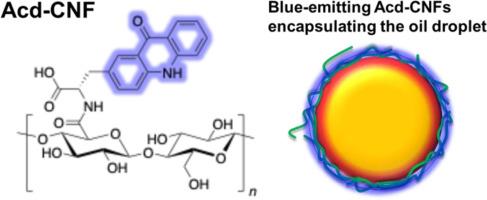接枝阿克啶-2-酰丙氨酸的蓝色荧光纤维素纳米纤维
IF 6.5
Q1 CHEMISTRY, APPLIED
Carbohydrate Polymer Technologies and Applications
Pub Date : 2025-06-24
DOI:10.1016/j.carpta.2025.100917
引用次数: 0
摘要
纤维素纳米纤维(CNFs)是一种生态友好型生物聚合物,由于其天然的两亲性,具有显著的触变性和皮克林乳化稳定性。在这项研究中,我们成功地通过acrion -2-yl-alanine (acrion -2-yl-alanine, Acd)与TEMPO-oxidized CNF (TOCNF)共价结合合成了add -CNF,在保持其水性的同时赋予了蓝色荧光。改性后的Acd-CNF在424-447 nm处显示蓝色荧光,具有与TOCNF相似的流变特性,具有增强的粘度和凝胶样行为。此外,添加- cnf在皮克林乳剂中作为荧光稳定剂。共聚焦激光扫描显微镜(CLSM)证实了其在水包油皮克林乳液中的界面定位,促进了Förster共振能量转移(FRET)到尼罗河红染色油。与易于非特异性吸附的传统染料不同,add - cnf能够直接荧光观察cnf,为乳液微成像提供了可靠的方法。该修饰增强了乳液的可视化和水分散行为,扩大了CNFs在基于荧光的微成像和可追溯性方面的应用。本文章由计算机程序翻译,如有差异,请以英文原文为准。

Blue-fluorescent cellulose nanofibers grafted with acridon-2-yl-alanine
Cellulose nanofibers (CNFs) are ecofriendly biopolymers with remarkable thixotropic properties and Pickering emulsification stability due to their native amphiphilicity. In this study, we successfully synthesized Acd-CNF by covalently binding acridon-2-yl-alanine (Acd) to TEMPO-oxidized CNF (TOCNF), imparting blue fluorescence while maintaining its aqueous properties. The modified Acd-CNF displayed blue fluorescence at 424–447 nm and exhibited rheological properties similar to TOCNF, with enhanced viscosity and gel-like behavior. Furthermore, Acd-CNF functioned as a fluorescent stabilizer in Pickering emulsions. Confocal laser scanning microscopy (CLSM) demonstrated its interfacial localization in oil-in-water Pickering emulsions, facilitating Förster resonance energy transfer (FRET) to Nile Red-stained oil. Unlike conventional dyes prone to nonspecific adsorption, Acd-CNF enables direct fluorescence observation of CNFs, offering a reliable approach for emulsion microimaging. The modification enhances emulsion visualization and water dispersion behavior, broadening CNFs’ applications in fluorescence-based micro imaging and traceability.
求助全文
通过发布文献求助,成功后即可免费获取论文全文。
去求助

 求助内容:
求助内容: 应助结果提醒方式:
应助结果提醒方式:


